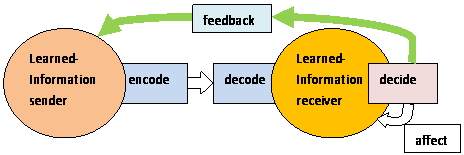| |
10. 1 Multiple modes
As mentioned in the M3C solution, learning can be understood from a communication model: Learning is the communication of information; and the Information might be from a person (the learner himself or another person), or from a media (textbook, digital tools etc.)
Multiple modes are the varied modes of representing and communicating information. When thinking it in terms of the communication model, multiple modes are equal to the multiple channels of delivering information.

According to Bruner (Driscoll, 2005), multiple modes of representing information are: enactive, iconic, and symbolic. Enactive mode is about what we do daily, like “the intelligence in muscle” especially for things that involves procedures; iconic mode is about information with imagery illustration; and symbolic mode is about language, music, mathematics, and other symbol system.
Receiving information is the process of decoding, and then deciding the further thoughts/actions/emotions based on the decoded information. Multiple modes can also be understood as various encoding-and-decoding schemes. For example, we can communicate with actions, imagery, and speech/writing.
From the multiple modes/channels learning communication model, we can draw three learning principles.
1. More channels are better for communication.
2. Bi-directional communication is better than uni-directional communication.
3. Translating/transforming between channels can help learning.
In order to apply the above learning principles, we try to link Bruner’s category of multiple modes with some current technology, and choose the following modes as multiple modes in B-learning system: Procedural, Smart Art, concept map, flow chart, cartoon, story-telling, math, and academic writing. Each mode is, more or less, the mixture of enactive, iconic, and symbolic modes.
Bruner admitted in his later works that, symbolic mode of thinking might have been over-cooked, and iconic thinking might have been undercooked.
We believe that the transferring/translating between various modes and integrating of various modes have been undercooked. So B-learning's multiple modes are designed aimed to enhance the transferring, translating, and integrating, especially with the aid of digital technology
Moreover, multiple modes principles can be related to other principles in M3C and theories such as: Bruner’s theory, CIP, Vygotsky’s theory etc.
- Login to post comments
